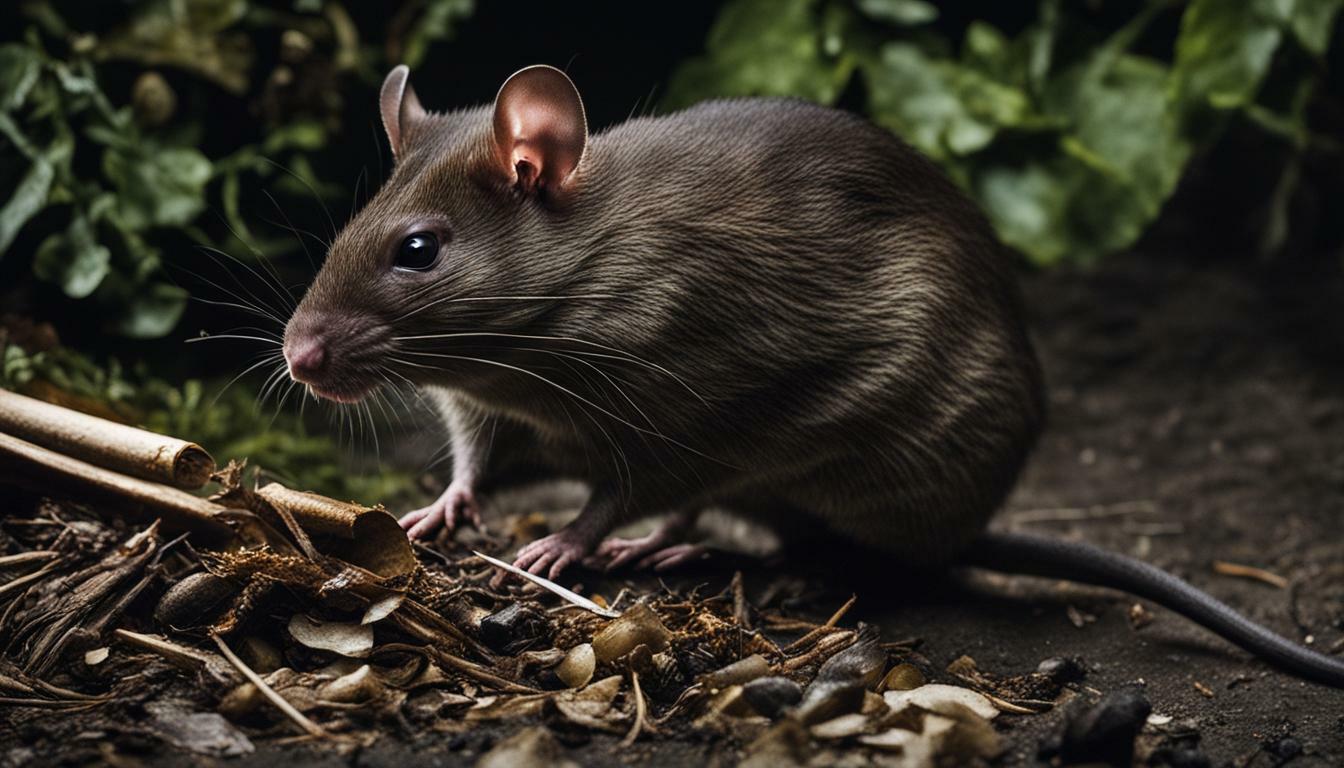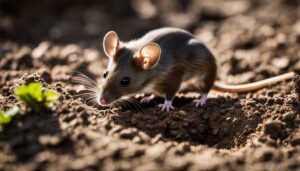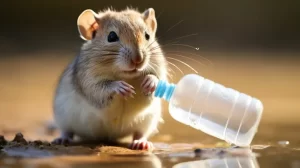Norway rats, also known as brown rats or sewer rats, can pose serious dangers to both public health and household safety. These pests are carriers of diseases such as plague, jaundice, rat-bite fever, and salmonellosis. Additionally, Norway rats can introduce fleas, ticks, and mites into homes, leading to further health concerns. Their destructive behavior, including gnawing on wires, pipes, drywall, and insulation, can cause extensive damage to structures and belongings. These rats tend to nest in basements, crawl spaces, and behind walls on the ground floor, impacting household safety and public health.
Key Takeaways
- Norway rats are dangerous pests that carry diseases such as plague, jaundice, rat-bite fever, and salmonellosis.
- They can introduce fleas, ticks, and mites into homes, leading to additional health risks.
- The destructive behavior of Norway rats can cause extensive damage to structures and belongings, including wires, pipes, drywall, and insulation.
- These rats have nesting habits that can impact household safety, choosing basements, crawl spaces, and areas behind walls on the ground floor.
- Exterminating Norway rats without professional help can be challenging, emphasizing the importance of seeking professional pest control services.
Diseases Carried by Norway Rats
Norway rats are known carriers of various diseases, which can pose significant health risks to humans. These pests can transmit diseases directly through bites or scratches, as well as indirectly through contact with their urine, droppings, or contaminated surfaces. It is important to be aware of the potential health risks associated with Norway rats to prevent the spread of these diseases.
One of the diseases carried by Norway rats is plague, a bacterial infection caused by Yersinia pestis. While rare, the plague can be severe and potentially fatal if left untreated. Another disease is jaundice, which is caused by the bacterium Leptospira. Rat-bite fever is another concern, caused by the bacteria Streptobacillus moniliformis or Spirillum minus. Additionally, salmonellosis, a type of food poisoning, can be transmitted through the consumption of food or water contaminated by rat feces.
Diseases Carried by Norway Rats:
| Disease | Causes |
|---|---|
| Plague | Bacterial infection (Yersinia pestis) |
| Jaundice | Bacterial infection (Leptospira) |
| Rat-bite fever | Bacterial infection (Streptobacillus moniliformis or Spirillum minus) |
| Salmonellosis | Food poisoning (transmitted through rat feces) |
Preventing Norway rat infestations and eliminating their presence is crucial for safeguarding public health. By implementing effective pest control measures and maintaining proper sanitation practices, you can minimize the risks associated with Norway rats. It is advisable to seek professional pest control services to ensure the thorough and safe eradication of these pests. Remember, early detection and intervention are key to preventing the spread of diseases carried by Norway rats and protecting the well-being of yourself and your loved ones.
Introduction of Parasites
In addition to carrying diseases, Norway rats can also introduce parasites into households, further compromising public health. These parasites, including fleas, ticks, and mites, can infest both rats and humans, spreading potential infections and causing discomfort.
“Parasites are a significant concern when it comes to Norway rat infestations,” says Dr. Emily Brown, a public health expert.
Their presence can lead to allergic reactions, skin irritations, and the transmission of diseases.
It is crucial to address rat infestations promptly to prevent the spread of parasites and mitigate their impact on public health.
Table: Common parasites introduced by Norway rats
| Parasite | Description |
|---|---|
| Fleas | These blood-sucking insects can cause itching, allergic reactions, and transmit diseases such as bubonic plague and murine typhus. |
| Ticks | Tick bites can lead to Lyme disease and other tick-borne illnesses, causing symptoms such as fever, fatigue, and joint pain. |
| Mites | Infestations by mites can result in skin irritations, intense itching, and the spread of skin infections. |
Rat infestations put households at risk of parasite bites and infestations. It is essential to take preventive measures to minimize contact with these disease-carrying pests.
- Sealing off entry points, such as gaps in walls and doors, can prevent rats from entering homes and bringing parasites with them.
- Removing potential food sources, such as open garbage cans and spilled pet food, reduces the rat population and discourages infestations.
- Keeping indoor and outdoor areas clean and clutter-free limits potential hiding places for rats and parasites.
If you suspect a rat infestation or notice signs of parasites, “contact a professional pest control service to effectively eliminate the rats and address any potential parasite problems,” advises Dr. Brown.
Destructive Behavior
Norway rats are notorious for their destructive behavior, causing damage to buildings and personal property. With their powerful incisors, they have the capability to gnaw on wires, pipes, drywall, insulation, and other building materials. This not only compromises the structural integrity of homes and commercial buildings but also poses a serious fire hazard. Rats chewing on electrical wires can cause short circuits, leading to electrical failures and potential fires.
Their destructive tendencies extend beyond damaging structures. Norway rats have a voracious appetite and will gnaw on stored food, contaminating it with their droppings, urine, and fur. This not only results in significant financial losses but also poses a health risk to humans. Consuming food that has been contaminated by rats can lead to food poisoning and various diseases.
“Rats can cause significant damage to homes and property, as well as pose health risks to humans. Their gnawing habit can compromise the structural integrity of buildings and create fire hazards. It is vital to address rat infestations promptly to prevent further harm.”
Moreover, Norway rats are known to be hoarders, collecting and storing various objects, such as paper, fabric, and insulation, to create their nests. This behavior can further contribute to the destruction of buildings, as they rip apart insulation and other materials for nesting purposes. The accumulation of nesting materials can also obstruct drainage and ventilation systems, leading to water damage and mold growth.
It is crucial to address rat infestations promptly to minimize the potential harm caused by their destructive behavior. Seeking professional pest control services is recommended, as they have the expertise and tools to eliminate rats effectively. Additionally, implementing preventive measures such as sealing off entry points, removing food sources, and reducing clutter can help deter these destructive pests from invading your property.
| Signs of Destructive Behavior by Norway Rats |
|---|
| Gnaw marks on wires, pipes, insulation, and other building materials |
| Chewed food packaging and contaminated food |
| Torn insulation and damaged nesting materials |
| Presence of rat droppings, urine stains, and gnawed objects |
Nesting Habits
Norway rats often nest in hidden areas of homes, posing potential health risks and safety concerns. These pests have a preference for basements, crawl spaces, and areas behind walls on the ground floor. Their ability to squeeze through small openings allows them to access these spaces easily, making it important to seal off any potential entry points.
When creating their nests, Norway rats will use a variety of materials, including shredded paper, fabric, and insulation. These nests can be quite large, providing a safe haven for rat populations to grow and thrive. The presence of these rats can be alarming, as they bring with them the potential for disease transmission and destructive behavior.
To effectively address a Norway rat infestation, it is crucial to locate and remove their nests. This can be a challenging task, as rats are adept at hiding their nests in hard-to-reach areas. Seeking professional pest control services is often the most efficient way to locate and eliminate these nests, ensuring the safety and well-being of your home and family.
Hidden Nesting Locations
To better understand the nesting habits of Norway rats, it is important to be aware of the potential areas they may choose as their hiding spots. Here are some common hidden nesting locations:
| Common Hidden Nesting Locations |
|---|
| Basements |
| Crawl spaces |
| Areas behind walls on the ground floor |
| Attics |
| Underneath floorboards |
By being aware of these potential nesting locations, you can take proactive measures to minimize the risk of a rat infestation. Regular inspections of these areas and prompt action in the event of any signs of rat activity can help prevent the potential health risks and safety concerns associated with Norway rats.
Challenges in Extermination
Exterminating Norway rats can be challenging and ineffective without the expertise of professional pest control services. These resilient rodents possess a remarkable ability to adapt and survive in various environments, making them difficult to eradicate through DIY methods alone.
When attempting to eliminate a Norway rat infestation without professional assistance, it’s common for individuals to underestimate the scale of the problem. These rats breed rapidly, with a single pair capable of producing up to 12 litters per year. This exponential growth can quickly overwhelm DIY control efforts.
Moreover, Norway rats are intelligent and cautious creatures. They quickly learn to avoid traps and bait stations, making it increasingly difficult to catch them. Their nocturnal nature further complicates matters, as they tend to remain hidden during the day, making visual identification and direct extermination attempts challenging.
To ensure effective eradication, professional pest control services employ a comprehensive approach. They have the knowledge, experience, and resources to accurately assess the extent of the infestation, develop targeted treatment plans, and implement proven eradication techniques. These experts utilize a combination of baiting, trapping, exclusion methods, and environmentally friendly rodenticides to ensure complete elimination of Norway rats from your property.
| Challenges in Extermination | Professional Pest Control Services |
|---|---|
| DIY methods are often ineffective | Utilizes proven eradication techniques |
| Rats breed rapidly, overwhelming individual control efforts | Accurate assessment of infestation extent |
| Rats are intelligent, avoiding traps and bait stations | Development of targeted treatment plans |
| Nocturnal nature makes visual identification challenging | Implementation of comprehensive eradication methods |
Prevention Measures
Taking proactive prevention measures is crucial in minimizing the risks associated with Norway rats and protecting household safety. By implementing the following strategies, you can significantly reduce the chances of a rat infestation in your home:
- Seal off entry points: Inspect your home for any gaps, cracks, or holes that rats could use as entryways. Use caulk or steel wool to seal off these openings and prevent rats from gaining access.
- Eliminate food sources: Rats are attracted to readily available food. Store your garbage in tightly sealed containers, clean up spills and crumbs immediately, and securely store food in metal or glass containers.
- Remove clutter: Rats seek out cluttered areas where they can hide and nest. Declutter your home by organizing storage areas, clearing out unnecessary items, and keeping the surroundings clean.
Additionally, it is essential to be aware of the signs of a rat infestation, such as droppings, gnaw marks, and unusual noises in the walls or ceilings. If you suspect an infestation, it is advisable to seek professional pest control services. These experts have the knowledge and experience to effectively eliminate Norway rats from your home and implement long-term prevention strategies.
By being proactive and implementing these prevention measures, you can safeguard your home and family from the health risks and destructive behavior associated with Norway rats.
| Danger | Prevention Measure |
|---|---|
| Disease transmission | Seal off entry points |
| Parasite infestation | Eliminate food sources |
| Destructive behavior | Remove clutter |
“Taking proactive prevention measures is crucial in minimizing the risks associated with Norway rats and protecting household safety.” – Pest Control Expert
Professional Pest Control Services
Professional pest control services are essential for efficiently eliminating Norway rats and preventing further harm. These skilled professionals have the knowledge and expertise to effectively address rat infestations, ensuring the safety and well-being of your home and family.
One of the key advantages of hiring professional pest control services is their ability to implement targeted and specialized techniques to exterminate Norway rats. They are well-versed in rat behavior and habits, allowing them to identify and target the areas of infestation accurately.
Additionally, professional pest control services utilize safe and effective methods to eliminate Norway rats without causing harm to humans or pets. They have access to advanced tools and products that are specifically designed to eradicate rat populations while minimizing any potential risks to the environment.
By enlisting the help of professionals, you can also benefit from their comprehensive approach to rat control. They not only focus on immediate elimination but also address the underlying causes of the infestation. This includes identifying and sealing off potential entry points, recommending sanitation measures, and providing ongoing monitoring to prevent rats from returning.
| Benefits of Professional Pest Control Services |
|---|
|
Conclusion
In conclusion, Norway rats are dangerous pests that can pose significant risks to public health and household safety if left unaddressed. These rodents are carriers of various diseases, including plague, jaundice, rat-bite fever, and salmonellosis, which can be transmitted to humans. Moreover, Norway rats can introduce fleas, ticks, and mites into homes, further exacerbating health concerns.
Their destructive behavior is another cause for concern, as they have a tendency to gnaw on wires, pipes, drywall, insulation, and other building materials. This can lead to extensive damage to structures and belongings, compromising the safety and integrity of homes and buildings.
Norway rats also have nesting habits that can impact household safety and public health. They prefer basements, crawl spaces, and areas behind walls on the ground floor, making it difficult to detect and address infestations.
While DIY methods of extermination may be tempting, these rats can be challenging to eliminate without professional help. Seeking the assistance of pest control services is crucial to effectively address infestations and prevent rats from returning. Additionally, implementing preventive measures such as sealing off entry points, eliminating food sources, and removing clutter can help reduce the risk of rat encounters.
Overall, it is essential to recognize the dangers associated with Norway rats and take proactive measures to mitigate their impact. By addressing infestations and implementing preventive strategies, you can protect your health and ensure the safety of your home. Don’t let these dangerous pests threaten your well-being, seek professional assistance and take preventative action today.
FAQ
Are Norway rats dangerous?
Yes, Norway rats are dangerous pests that can carry diseases and cause extensive damage to structures and belongings.
What diseases can Norway rats carry?
Norway rats can carry diseases such as plague, jaundice, rat-bite fever, and salmonellosis.
How do Norway rats introduce parasites into homes?
Norway rats can introduce fleas, ticks, and mites into homes, which can lead to further health concerns.
What kind of destructive behavior do Norway rats exhibit?
Norway rats have a tendency to gnaw on wires, pipes, drywall, insulation, and other building materials, causing extensive damage.
Where do Norway rats nest?
Norway rats nest in basements, crawl spaces, and behind walls on the ground floor of buildings.
Can I exterminate Norway rats without professional help?
Exterminating Norway rats can be difficult without professional help. DIY methods may be ineffective.
How can I prevent Norway rat infestations?
To prevent Norway rat infestations, it is important to seal off entry points, eliminate food sources, and remove clutter.
How can professional pest control services help with Norway rat infestations?
Professional pest control services can effectively eliminate Norway rats and prevent them from returning.
What are the main points to remember about Norway rats?
Norway rats are dangerous pests that carry diseases, introduce parasites, exhibit destructive behavior, and can be difficult to exterminate. Prevention measures and professional help are recommended.




